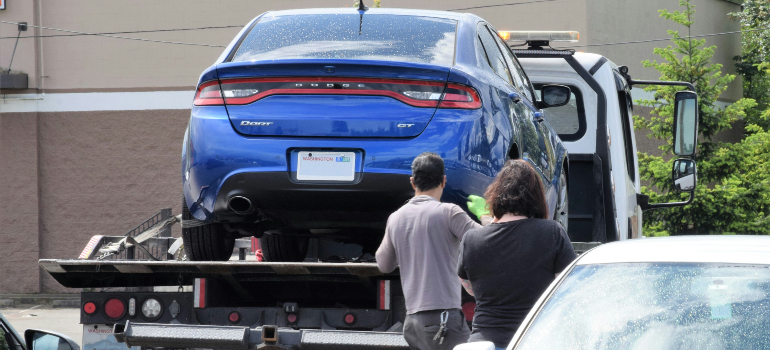Moving a car to a different state can feel like a big task, especially with all the rules and regulations involved. Whatever the reason for your move may be, it’s important to know what steps you need to take to ensure everything goes smoothly. From understanding state laws to choosing how to transport your car, a little preparation can save you time and hassle.
1. Research the state’s vehicle regulations
Each state has its own rules and regulations for vehicle registration and inspections. You should familiarize yourself with these before moving your car. Here’s a simple checklist to get started:
- Check registration requirements. Some states have specific rules for new residents regarding how long they can drive before registering their car.
- Review inspection rules. Certain states require safety or emissions inspections before your car can be registered.
- Look into taxes and fees. Be aware of any taxes, such as sales tax or personal property tax, that may apply when registering your car.
- Confirm insurance requirements. Make sure your auto insurance policy meets the minimum coverage required in your new state.
- Gather required documents. You may need your car title, proof of insurance, and identification to complete the registration process.
2. Update your insurance policy
Before moving a car to a different state, you’ll need to update your auto insurance policy to meet the requirements of your new location. Each state has its own rules about minimum coverage, so it’s best to check what’s required. For example, some states may have higher liability limits or require additional coverage, like uninsured motorist protection. According to the moving companies the DC area offers, it’s a good idea to contact your insurance provider early in the process to make sure you’re covered as soon as your car arrives. Be sure to ask about any discounts that might be available based on your new location, as insurance rates can vary widely from state to state. This small step can help you avoid any gaps in coverage and ensure you’re driving legally once you settle in.

3. Get your car ready for transport
Preparing your car before it’s shipped is a key step to avoid any issues during the move. Start by cleaning both the interior and exterior of your car. This helps you notice any pre-existing damage and makes it easier to inspect the vehicle upon arrival. Take detailed photos of your car from different angles to document its condition. For example, Washington DC residential movers advise their clients to also remove any personal items from the car, as transport companies usually won’t cover damage to belongings left inside. It’s also smart to check your car’s fluids, battery, and tire pressure to ensure everything is in good shape. Lastly, make sure you have a quarter tank of gas – enough to move the car on and off the truck but not so much that it adds unnecessary weight.
4. When moving a car to a different state choose the right shipping method
Choosing the right shipping method is essential. There are two main options: open and enclosed transport. Open transport is the most common and cost-effective choice, but it leaves your car exposed to weather and road debris. Enclosed transport, on the other hand, offers more protection but comes at a higher price. If you have a luxury or classic car, enclosed transport may be worth the extra cost. Interstate movers DC residents trust say that comparing prices and services from different carriers is something you should do to find the best fit for your needs. Another option is driving the car yourself or hiring a professional driver, which could be more convenient for shorter distances. Each method has its pros and cons, so consider your budget and the level of protection you want for your vehicle.

5. Timing and scheduling your move
Proper timing is key to ensuring a smooth car move. Here’s what to keep in mind when planning:
- Book early. Car shipping companies can get booked up, especially during peak moving seasons.
- Consider the season. Summer is a busy time for movers, which can lead to delays and higher costs. Winter moves, especially in snowy regions, may also cause challenges.
- Prepare for flexible dates. Shipping companies often provide a delivery window rather than an exact date, so be ready for some flexibility.
- Coordinate with your move. If you’re moving your household, try to schedule your car shipment around the same time to simplify the process.
- Check weather conditions. Extreme weather may delay your car’s transport, so keep an eye on forecasts.
6. Be aware of vehicle registration deadlines
When you move to a new state, registering your car is a must to avoid fines and legal issues. Each state has its timeline for registering vehicles, and missing the deadline could lead to penalties. Most states require you to register your car within 30 to 90 days of becoming a resident. In case you decide to hire movers DC residents speak highly of, they may be able to assist with understanding the local requirements and timelines. It’s also important to have the necessary documents ready, like your car’s title, proof of insurance, and a valid ID. Additionally, some states might require a vehicle inspection or emissions test before registration is complete. Be sure to check your state’s Department of Motor Vehicles (DMV) website to confirm the specific rules and deadlines where you’re relocating.
7. Double-check state-specific fees and taxes
Moving your car across state lines can come with unexpected fees. Here’s a list of potential costs you may encounter:
- Title transfer fees: Most states require a fee to transfer your car’s title to your new state.
- Vehicle registration fees: These fees vary widely from state to state, so check your new state’s rates.
- Sales or use tax: Some states may charge a tax when you register your vehicle, even if you’ve already paid it in your previous state.
- Inspection fees: If your new state requires safety or emissions inspections, you’ll need to pay for these tests.
- License plate fees: In some states, you’ll also need to pay for new license plates when registering your car.

Ensure your vehicle has a hassle-free transfer
Moving your car across state lines doesn’t have to be stressful if you’re well-prepared. The steps mentioned above are designed to make sure a person who is moving a car to a different state does this complicated task without a glitch. In essence, staying organized and aware of deadlines will help you avoid costly mistakes and ensure that your car is ready to hit the road in your new location.


